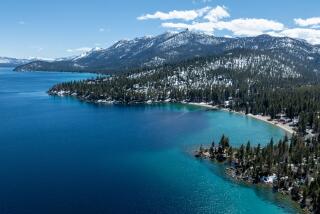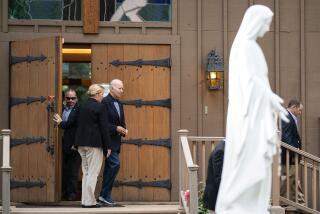The Fight for Tahoe’s Life
- Share via
In 1861, Mark Twain wrote that Lake Tahoe, 22 miles long and 12 wide, was so clear that even at a depth of 80 feet “every little pebble was distinct, every speckled trout.” A dozen years later, geologist John LeConte lowered a white dinner plate into the water. It was still visible at a depth of 108 feet.
That was before the forests were clear-cut to provide timber for the Comstock mines, before grazing livestock polluted streams running into the lake and before the urbanization of the Tahoe Basin. The basin population grew fivefold between 1960 and 1980 and is more than 50,000 today.
By the late 1960s, the dinner plate was visible to only 90 feet. Tahoe was in crisis--a possibly irreversible clouding of the pristine waters by pollution-caused algae. Then big government stepped in and a slow success story began.
The latest development is the U.S. Supreme Court’s landmark decision last week to uphold the authority of the California-Nevada Tahoe Regional Planning Agency to halt home construction in the Tahoe Basin while it develops a plan to reduce lake pollution. The decision has no immediate effect because the moratorium occurred years ago and the lands in question were never built on. But the ruling is monumental in a broad sense because it upholds the power of state, federal and local government to restrict land uses to protect the environment.
The planning agency was created by California, Nevada and Congress in 1969 after Govs. Ronald Reagan and Paul Laxalt held an urgent summit at the lake. They agreed that the only solution was creation of a super- government agency, even though that concept violated their conservative beliefs.
The lake, at 6,225 feet elevation, and its surrounding ridges and peaks, rising to 11,000 feet, were abused for 150 years. They will not heal quickly even with planning and growth-control regulations that are among the nation’s most stringent.
It’s been a long struggle against erosion, sewage effluent, casinos and landowner lawsuits. Federal, state and local governments have spent hundreds of millions of dollars buying land and developing erosion control and wetlands restoration projects. Hundreds of millions more are needed.
The dinner plate was visible to only 64 feet in 1997. But this year, the figure is up to nearly 74 feet. Does that mean all this effort is finally paying off? Too early to say. Planners say the lake is quick to react to negative changes in the watershed--one year’s higher-than-usual runoff, for example--and very slow to respond to restoration efforts. But it will. And there’s no doubt that without the planning agency, the controls and all the effort of the past 30 years, Lake Tahoe would have deteriorated to well beyond the saving point.
More to Read
Sign up for Essential California
The most important California stories and recommendations in your inbox every morning.
You may occasionally receive promotional content from the Los Angeles Times.













